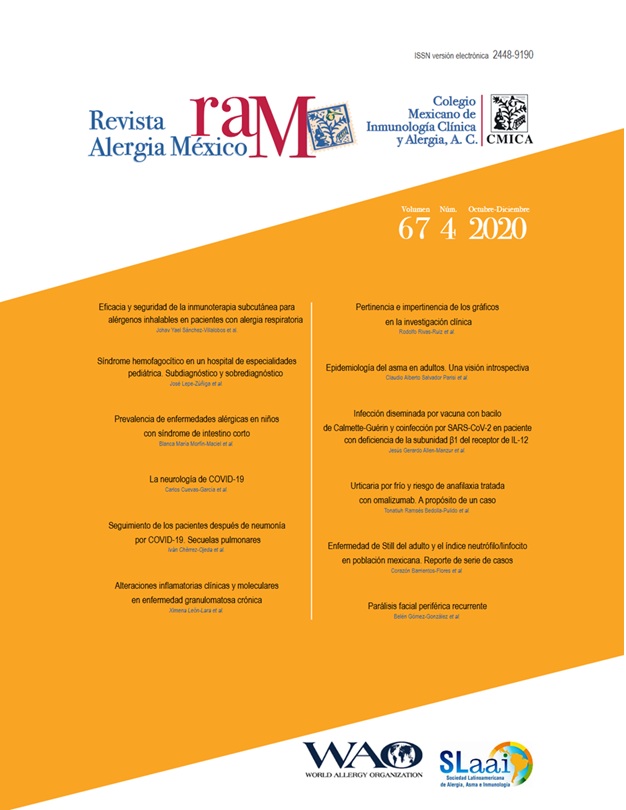Resumen
Antecedentes: Omalizumab, un anticuerpo monoclonal anti-IgE, recientemente es utilizado como una opción en el tratamiento de la urticaria inducible.
Caso clínico: Describimos el caso de una mujer de 46 años referida al Servicio de Alergia e Inmunología del Hospital Civil de Guadalajara Dr. Juan I. Menchaca, por historia de urticaria, picazón en el cuerpo, cambios en el color de la piel tras la exposición al agua y opresión en el pecho posterior el consumo de bebidas frías; en consecuencia, ella limitaba sus actividades al aire libre y de higiene personal. Se realizaron pruebas de desafío con calor, toalla húmeda, caminata en banda sinfín y dermografismo, las cuales fueron negativas; la prueba del cubo de hielo fue positiva. Para establecer la velocidad de la formación de la roncha establecimos intervalos de exposición al frío durante uno, tres, cinco y 10 minutos; se obtuvo un resultado positivo desde el tercer minuto. Debido a la mala respuesta al tratamiento farmacológicos y a las medidas para evitar el frío, así como por la mala calidad de vida, el alto riesgo de anafilaxis y el advenimiento de la temporada de invierno, se administraron 150 mg/mes de omalizumab durante la temporada de invierno. Después de la primera dosis no se notificaron episodios de urticaria en zonas expuestas al frío; la prueba del cubo de hielo antes de la segunda dosis y en los meses siguientes fue negativa y la paciente pudo ingerir bebidas y alimentos fríos. No se produjeron reacciones adversas atribuibles al uso de omalizumab. Tres años después de la primera dosis, la paciente permanecía asintomática.
Conclusión: El caso descrito constituye uno de los primeros de urticaria inducida por el frío con riesgo de anafilaxia con respuesta positiva a omalizumab, lo que se reflejó en el control de los síntomas y la mejoría en la calidad de vida.
Referencias
Siebenhaar F, Weller K, Mlynek A, Magerl M, Altrichter S, Vieira-Dos Santos R, et al. Acquired cold urticaria: clinical picture and update on diagnosis and treatment. Clin Exp Dermatol. 2007;32(3):241-245. DOI: 10.1111/j.1365-2230.2007.02376.x.
Wanderer AA. Cold urticaria syndromes: historical background, diagnostic classification, clinical and laboratory characteristics, pathogenesis, and management. J Allergy Clin Immunol. 1990;85(6):965-981. DOI: 10.1016/0091-6749(90)90037-5
Alangari AA, Twarog FJ, Shih MC, Schneider LC. Clinical features and anaphylaxis in children with cold urticaria. Pediatrics. 2004;113(4):313-317. DOI: 10.1542/peds.113.4.e313
Zuberbier T, Aberer W, Asero R, Abdul Latiff AH, Baker D, Ballmer-Weber B, et al. The EAACI/GA²LEN/EDF/WAO guideline for the definition, classification, diagnosis and management of urticaria. Allergy. 2018;73(7):1393-1414. DOI: 10.1111/all.1339
Aguilar-Hinojosa NK, Segura-Méndez NH, Lugo-Reyes SO. Correlación de la gravedad de urticaria crónica y la calidad de vida. Rev Alerg Mex. 2012;59(4):180-186.
Jain SV, Mullins RJ. Cold urticaria: a 20-year follow-up study. J Eur Acad Dermatol Venereol. 2016;30(12):2066-2071. DOI: 10.1111/jdv.13841
Boyce JA. Successful treatment of cold-induced urticaria/anaphylaxis with anti-IgE. J Allergy Clin Immunol. 2006;117(6):1415-1418. DOI: 10.1016/j.jaci.2006.04.003.
Metz M, Schütz A, Weller K, Gorczyza M, Zimmer S, Staubach P, et al. Omalizumab is effective in cold urticaria-results of a randomized placebo-controlled trial. J Allergy Clin Immunol. 2017;140(3):864-867. DOI: 10.1016/j.jaci.2017.01.043
Guyatt GH, Haynes RB, Jaeschke RZ, Cook DJ, Green L, Naylor CD, et al. User’s guides to the medical literature: XXV. Evidence-based medicine: principles for applying the user’s guides to patient care. Evidence-Based Medicine Working Group. JAMA. 2000;284(10):1290-1296. DOI: 10.1001/jama.284.10.1290

Esta obra está bajo una licencia internacional Creative Commons Atribución-NoComercial 4.0.
Derechos de autor 2021 Revista Alergia México





